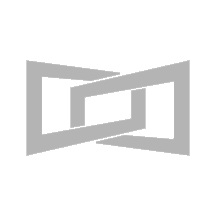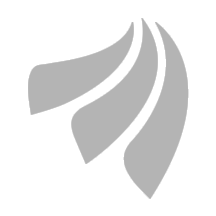全文 | 2024年AIPPI杭州决议
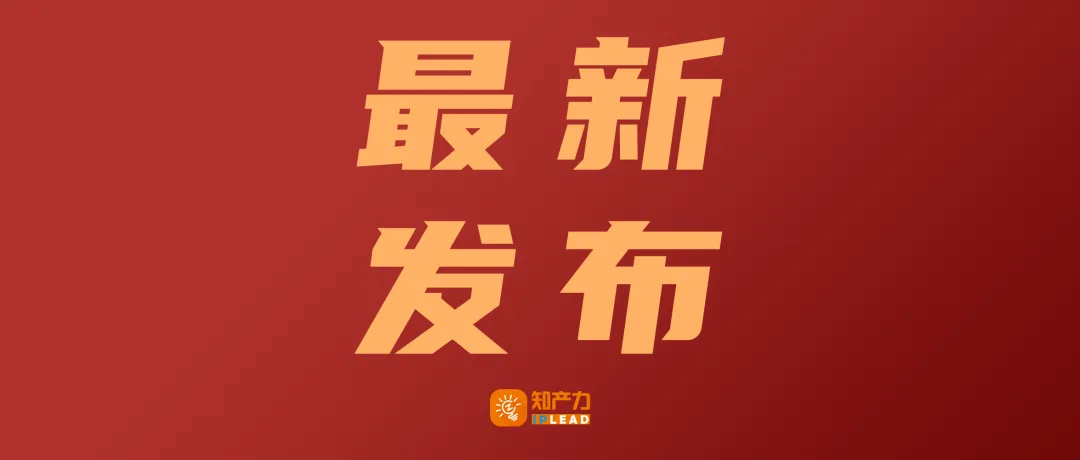
来源 | AIPPI
中文编译 | 布鲁斯
知产力11月14日获悉,当地时间11月12日,2024年国际保护知识产权协会(AIPPI)世界知识产权大会执委会会议审议通过的《2024年AIPPI杭州决议》在国际保护知识产权协会(AIPPI)网站公布,将成为相关国际组织和各国政府制定知识产权法律政策的重要参考。
今年(2024年)10月22日,为期4天的2024年国际保护知识产权协会(AIPPI)世界知识产权大会在杭州闭幕。来自全球92个国家和地区的约2300名知识产权界人士汇聚杭州,围绕“知识产权的平衡保护与创新发展”这一大会主题,开展了约百场交流活动,广泛凝聚合作共识、激发创新活力。
《2024年AIPPI杭州决议》是大会的核心成果之一。这一决议包括“披露要求及不遵守后果的国际协调”“包含非显著性表述的组合商标的冲突”“著作权领域的戏仿抗辩”“无端的知识产权侵权指控”四个研究专题,涉及专利、商标、著作权、权利行使等领域。
据介绍,《2024年AIPPI杭州决议》正式发布后将被提交世界知识产权组织(WIPO)、世界贸易组织(WTO),以及世界主要国家和地区的立法机关、知识产权行政管理机关和司法机关等,成为相关国际组织、各国政府制定知识产权法律和政策的重要参考。
以下为《2024年AIPPI杭州决议》英文原文及知产力翻译的中文版本,中文译文仅供参考,请以官方发布内容为准。点击文末“阅读原文”,即可下载知产力翻译版中英文Word文档。
Q289-RES-2024
披露要求及不遵守后果的国际协调
英文(图片版,共3页)
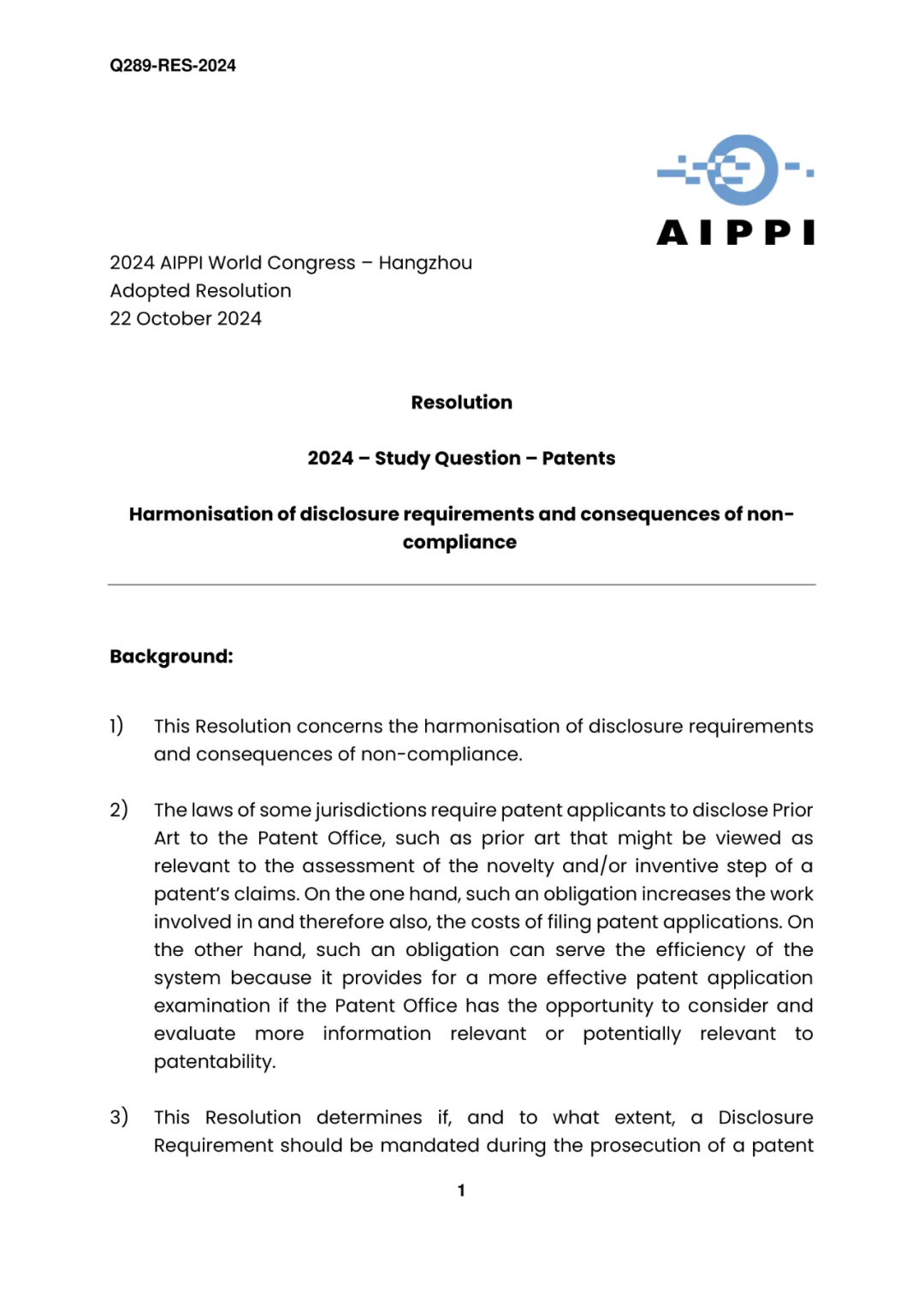
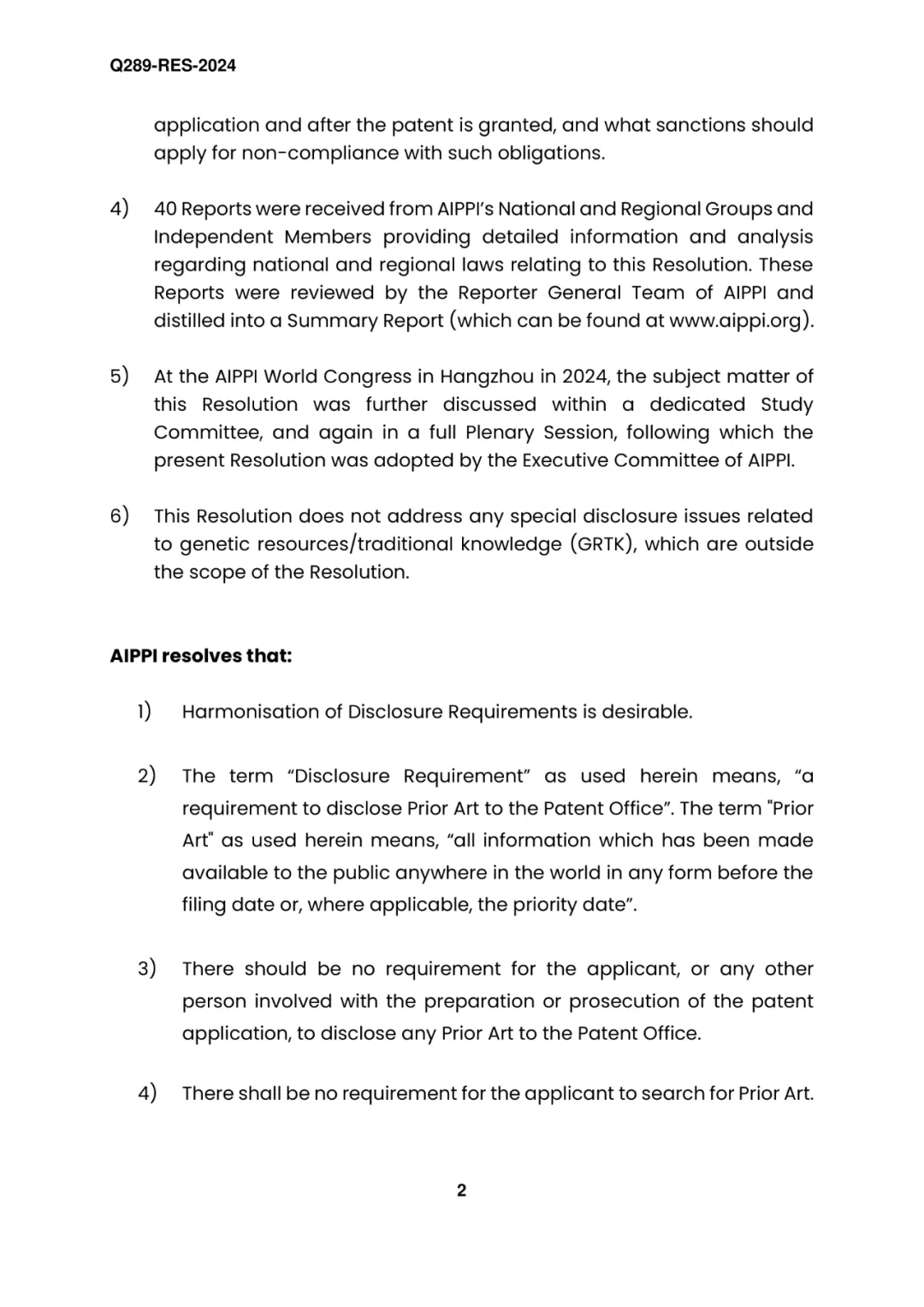
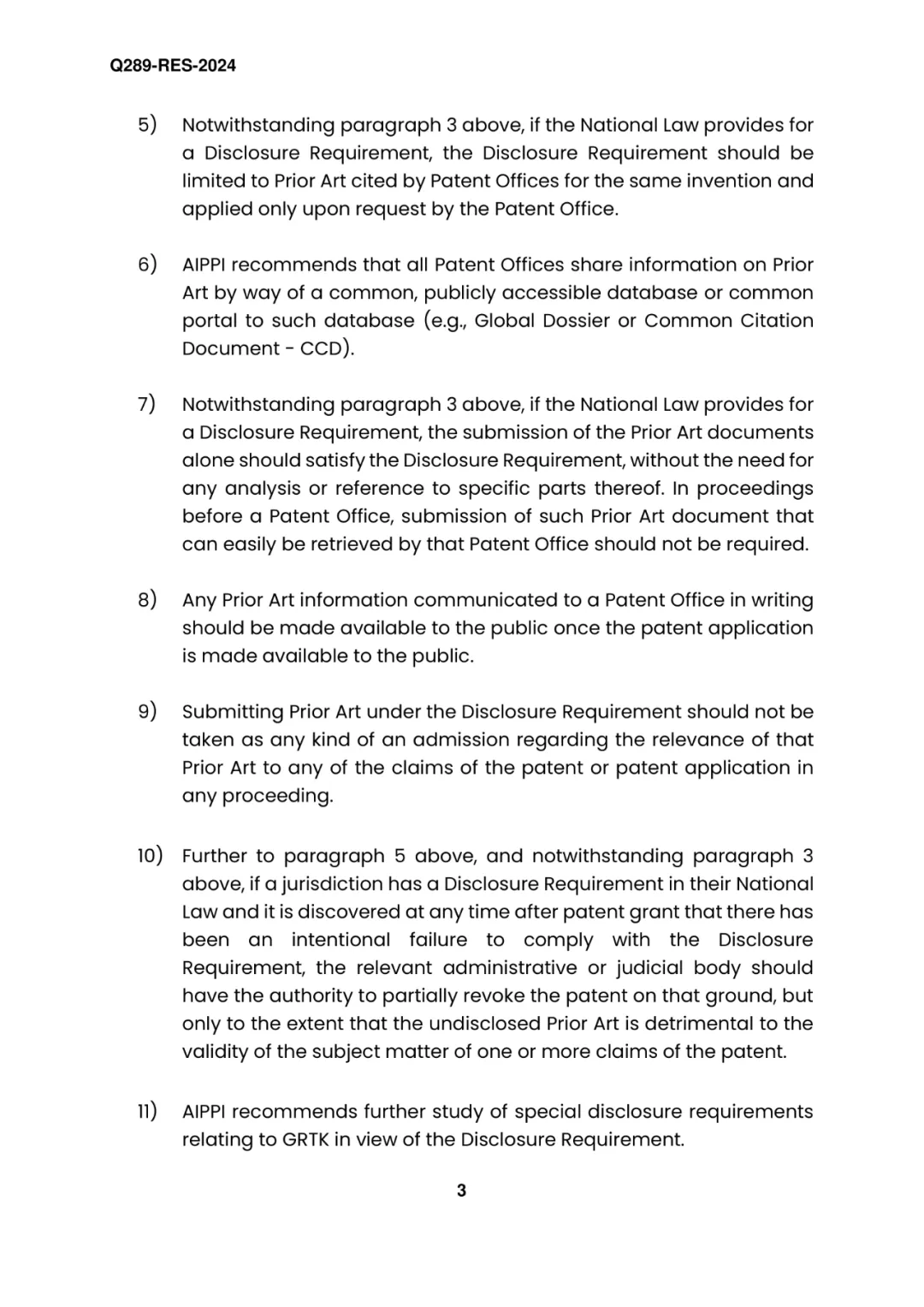
英文(文字版)
Q289-RES-2024
2024 AIPPI World Congress – Hangzhou
Adopted Resolution
22 October 2024
Resolution
2024 – Study Question – Patents
Harmonisation of disclosure requirements and consequences of non compliance
Background:
1) This Resolution concerns the harmonisation of disclosure requirements and consequences of non-compliance.
2) The laws of some jurisdictions require patent applicants to disclose Prior Art to the Patent Office, such as prior art that might be viewed as relevant to the assessment of the novelty and/or inventive step of a patent’s claims. On the one hand, such an obligation increases the work involved in and therefore also, the costs of filing patent applications. On the other hand, such an obligation can serve the efficiency of the system because it provides for a more effective patent application examination if the Patent Office has the opportunity to consider and evaluate more information relevant or potentially relevant to patentability.
3) This Resolution determines if, and to what extent, a Disclosure Requirement should be mandated during the prosecution of a patent application and after the patent is granted, and what sanctions should apply for non-compliance with such obligations.
4) 40 Reports were received from AIPPI’s National and Regional Groups and Independent Members providing detailed information and analysis regarding national and regional laws relating to this Resolution. These Reports were reviewed by the Reporter General Team of AIPPI and distilled into a Summary Report (which can be found at www.aippi.org).
5) At the AIPPI World Congress in Hangzhou in 2024, the subject matter of this Resolution was further discussed within a dedicated Study Committee, and again in a full Plenary Session, following which the present Resolution was adopted by the Executive Committee of AIPPI.
6) This Resolution does not address any special disclosure issues related to genetic resources/traditional knowledge (GRTK), which are outside the scope of the Resolution.
AIPPI resolves that:
1) Harmonisation of Disclosure Requirements is desirable.
2) The term “Disclosure Requirement” as used herein means, “a requirement to disclose Prior Art to the Patent Office”. The term "Prior Art" as used herein means, “all information which has been made available to the public anywhere in the world in any form before the filing date or, where applicable, the priority date”.
3) There should be no requirement for the applicant, or any other person involved with the preparation or prosecution of the patent application, to disclose any Prior Art to the Patent Office.
4) There shall be no requirement for the applicant to search for Prior Art.
5) Notwithstanding paragraph 3 above, if the National Law provides for a Disclosure Requirement, the Disclosure Requirement should be limited to Prior Art cited by Patent Offices for the same invention and applied only upon request by the Patent Office.
6) AIPPI recommends that all Patent Offices share information on Prior Art by way of a common, publicly accessible database or common portal to such database (e.g., Global Dossier or Common Citation Document - CCD).
7) Notwithstanding paragraph 3 above, if the National Law provides for a Disclosure Requirement, the submission of the Prior Art documents alone should satisfy the Disclosure Requirement, without the need for any analysis or reference to specific parts thereof. In proceedings before a Patent Office, submission of such Prior Art document that can easily be retrieved by that Patent Office should not be required.
8) Any Prior Art information communicated to a Patent Office in writing should be made available to the public once the patent application is made available to the public.
9) Submitting Prior Art under the Disclosure Requirement should not be taken as any kind of an admission regarding the relevance of that Prior Art to any of the claims of the patent or patent application in any proceeding.
10) Further to paragraph 5 above, and notwithstanding paragraph 3 above, if a jurisdiction has a Disclosure Requirement in their National Law and it is discovered at any time after patent grant that there has been an intentional failure to comply with the Disclosure Requirement, the relevant administrative or judicial body should have the authority to partially revoke the patent on that ground, but only to the extent that the undisclosed Prior Art is detrimental to the validity of the subject matter of one or more claims of the patent.
11) AIPPI recommends further study of special disclosure requirements relating to GRTK in view of the Disclosure Requirement.
中文
Q289-RES-2024
2024年AIPPI世界知识产权大会 – 杭州
通过的决议
2024年10月22日
决议
2024 – 研究专题 – 专利
披露要求及不遵守后果的国际协调
背景:
1) 本决议涉及披露要求及不遵守后果的国际协调。
2) 一些司法管辖区的法律要求专利申请人向专利局披露现有技术,例如可能被视为与评估专利权利要求的新颖性和/或创造性相关的现有技术。一方面,这种义务增加了提交专利申请的工作量,因此也增加了提交专利申请的成本。另一方面,这种义务可以提高系统的效率,因为如果专利局有机会考虑和评估更多与可专利性相关或者可能相关的信息,专利申请的审查将更为有效。
3) 本决议确定了在专利申请审查期间和专利授予后是否应当强制要求披露,以及应当在何种程度上强制要求,以及不遵守此类义务应当适用何种制裁。
4) AIPPI国家及地区小组和独立成员提交了40份报告,就本决议相关的国家和地区法律提供了详细信息和分析。这些报告由AIPPI的报告总团队审查并提炼成一份总结报告(可在www.aippi.org查阅)。
5) 在2024年杭州举行的AIPPI世界知识产权大会上,本决议的主题在专门的研究委员会内进行了进一步讨论,并在全体会议上再次进行了讨论,随后AIPPI执行委员会通过了本决议。
6) 本决议不涉及与遗传资源/传统知识(GRTK)相关的任何特殊披露问题,这些问题超出了本决议的范围。
AIPPI决议如下:
1) 对披露要求进行国际协调是可取的。
2) 本决议使用的“披露要求”一词是指“向专利局披露现有技术的要求”。本决议使用的“现有技术”一词是指“在申请日或者优先权日(如适用)之前,在世界任何地方以任何形式向公众提供的所有信息”。
3) 不应当要求申请人,或者参与专利申请准备、审查的任何其他人向专利局披露任何现有技术。
4) 不应当要求申请人检索现有技术。
5) 尽管有上述第3段所述内容,如果国家法律规定了披露要求,则披露要求应当限于专利局为同一发明引用的现有技术,并且仅在专利局提出要求时适用。
6) AIPPI建议所有专利局通过通用的、可公开访问的数据库或者此类数据库的公共门户(例如,全球档案或者通用引文文件 - CCD)共享现有技术信息。
7) 尽管有上述第3段所述内容,如果国家法律规定了披露要求,则仅提交现有技术文件就应当满足公开要求,而无需对其特定部分进行任何分析或者引用。在专利局进行的程序中,不应当要求提交该专利局可以轻松检索的此类现有技术文件。
8) 一旦专利申请向公众公开,以书面形式传达给专利局的任何现有技术信息也都应当向公众提供。
9) 根据披露要求提交现有技术,不应当被视为对该现有技术与任何程序中专利或者专利申请的任何权利要求的相关性的任何形式的承认。
10) 在上述第5段的基础上,尽管有上述第3段所述内容,如果一个司法管辖区在其国内法中规定了披露要求,并且在专利授予后的任何时间发现存在故意未遵守披露要求的情况,则相关行政或者司法机构应当有权以此为由部分撤销该专利,但仅限于未公开的现有技术对专利的一项或者多项权利要求的客体的有效性有害的程度。
11) 鉴于披露要求,AIPPI建议进一步研究与遗传资源/传统知识相关的特殊披露要求。
Q290-RES-2024
包含非显著性表述的组合商标的冲突
英文(图片版,共3页)
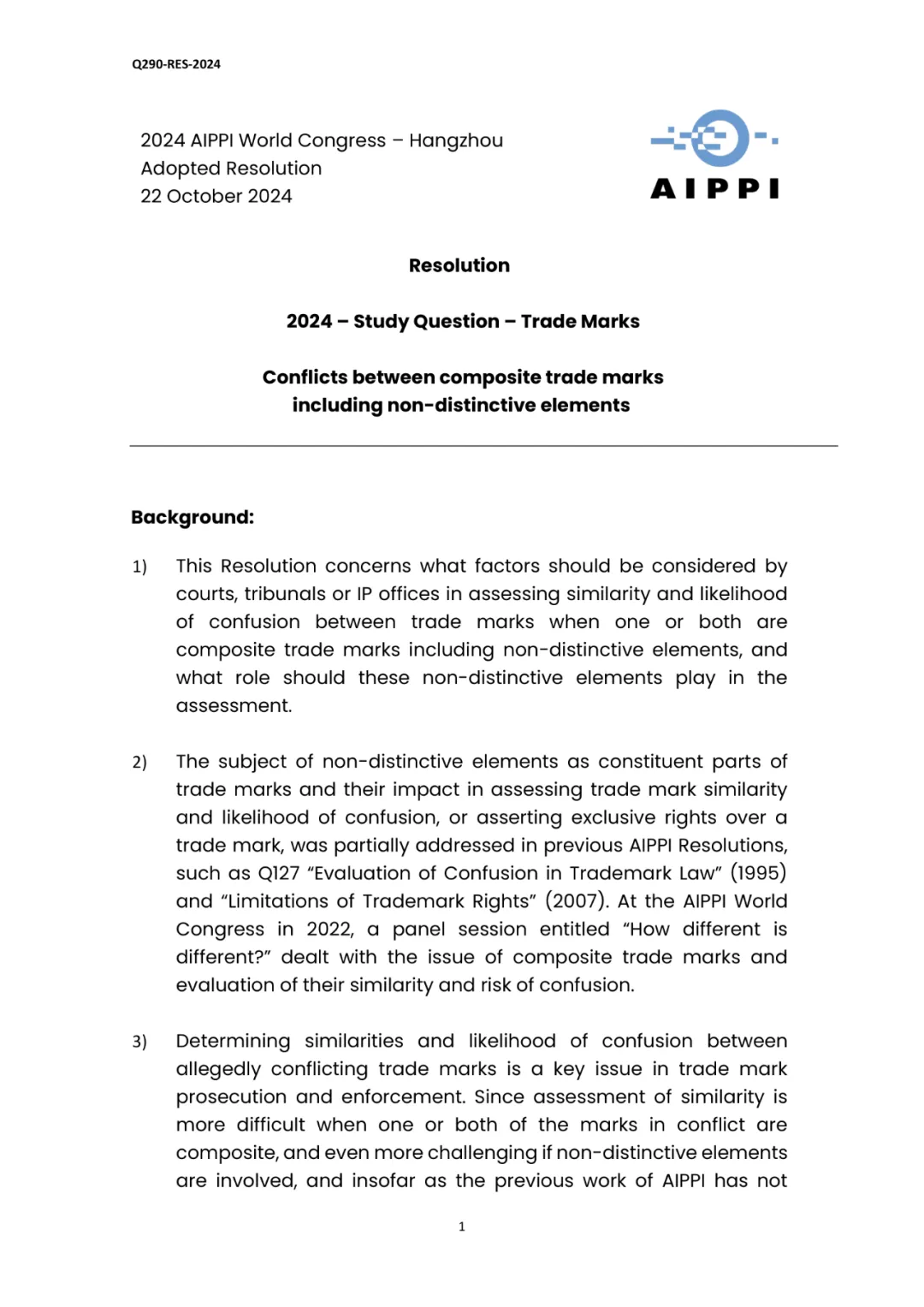
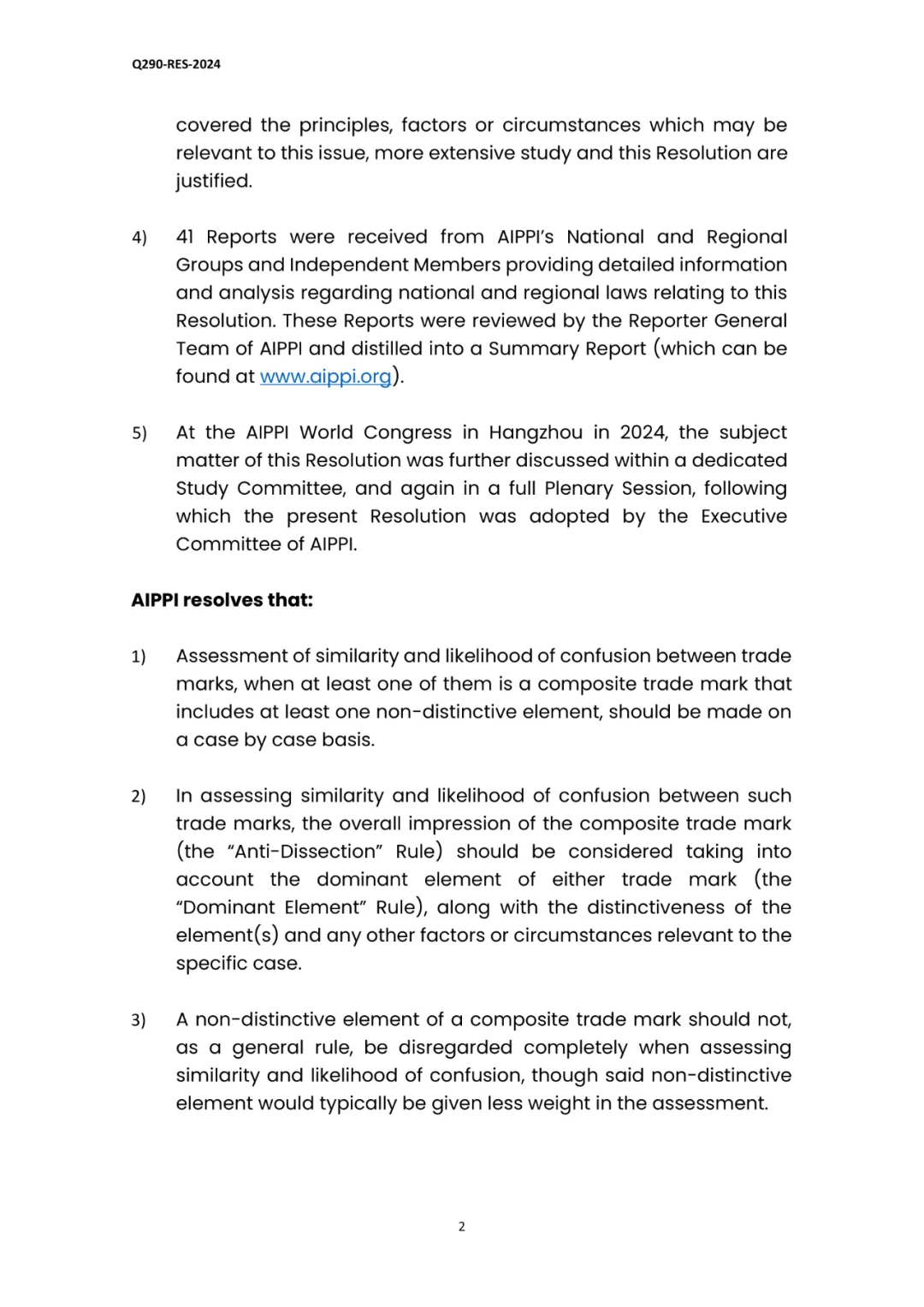
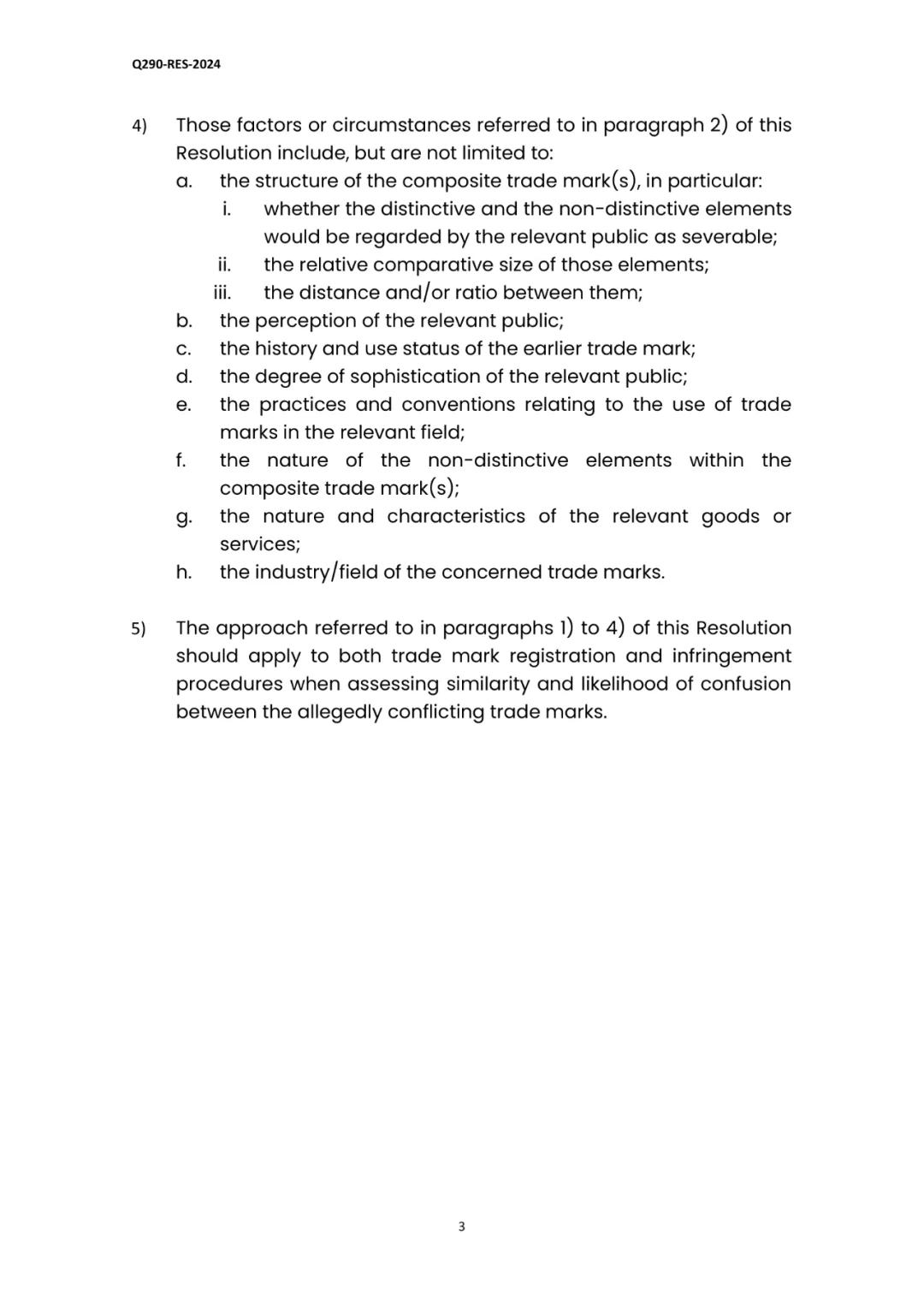
英文(文字版)
Q290-RES-2024
2024 AIPPI World Congress – Hangzhou
Adopted Resolution
22 October 2024
Resolution
2024 – Study Question – Trade Marks
Conflicts between composite trade marks including non-distinctive elements
Background:
1) This Resolution concerns what factors should be considered by courts, tribunals or IP offices in assessing similarity and likelihood of confusion between trade marks when one or both are composite trade marks including non-distinctive elements, and what role should these non-distinctive elements play in the assessment.
2) The subject of non-distinctive elements as constituent parts of trade marks and their impact in assessing trade mark similarity and likelihood of confusion, or asserting exclusive rights over a trade mark, was partially addressed in previous AIPPI Resolutions, such as Q127 “Evaluation of Confusion in Trademark Law” (1995) and “Limitations of Trademark Rights” (2007). At the AIPPI World Congress in 2022, a panel session entitled “How different is different?” dealt with the issue of composite trade marks and evaluation of their similarity and risk of confusion.
3) Determining similarities and likelihood of confusion between allegedly conflicting trade marks is a key issue in trade mark prosecution and enforcement. Since assessment of similarity is more difficult when one or both of the marks in conflict are composite, and even more challenging if non-distinctive elements are involved, and insofar as the previous work of AIPPI has not covered the principles, factors or circumstances which may be relevant to this issue, more extensive study and this Resolution are justified.
4) 41 Reports were received from AIPPI’s National and Regional Groups and Independent Members providing detailed information and analysis regarding national and regional laws relating to this Resolution. These Reports were reviewed by the Reporter General Team of AIPPI and distilled into a Summary Report (which can be found at www.aippi.org).
5) At the AIPPI World Congress in Hangzhou in 2024, the subject matter of this Resolution was further discussed within a dedicated Study Committee, and again in a full Plenary Session, following which the present Resolution was adopted by the Executive Committee of AIPPI.
AIPPI resolves that:
1) Assessment of similarity and likelihood of confusion between trade marks, when at least one of them is a composite trade mark that includes at least one non-distinctive element, should be made on a case by case basis.
2) In assessing similarity and likelihood of confusion between such trade marks, the overall impression of the composite trade mark (the “Anti-Dissection” Rule) should be considered taking into account the dominant element of either trade mark (the “Dominant Element” Rule), along with the distinctiveness of the element(s) and any other factors or circumstances relevant to the specific case.
3) A non-distinctive element of a composite trade mark should not, as a general rule, be disregarded completely when assessing similarity and likelihood of confusion, though said non-distinctive element would typically be given less weight in the assessment.
4) Those factors or circumstances referred to in paragraph 2) of this Resolution include, but are not limited to:
a. the structure of the composite trade mark(s), in particular:
i. whether the distinctive and the non-distinctive elements would be regarded by the relevant public as severable;
ii. the relative comparative size of those elements;
iii. the distance and/or ratio between them;
b. the perception of the relevant public;
c. the history and use status of the earlier trade mark;
d. the degree of sophistication of the relevant public;
e. the practices and conventions relating to the use of trade marks in the relevant field;
f. the nature of the non-distinctive elements within the composite trade mark(s);
g. the nature and characteristics of the relevant goods or services;
h. the industry/field of the concerned trade marks.
5) The approach referred to in paragraphs 1) to 4) of this Resolution should apply to both trade mark registration and infringement procedures when assessing similarity and likelihood of confusion between the allegedly conflicting trade marks.
中文
Q290-RES-2024
2024年AIPPI世界知识产权大会 – 杭州
通过的决议
2024年10月22日
决议
2024 – 研究专题 – 商标
包含非显著性表述的组合商标的冲突
背景:
1) 本决议涉及法院、审裁处或者知识产权局在对两个商标之间的近似性和混淆可能性的评估中,当其中一个或者两个商标是包含非显著要素的组合商标时,应当考虑哪些因素,以及这些非显著要素在评估中应当发挥什么作用。
2) 作为商标组成部分的非显著要素及其在评估商标近似性和混淆可能性、或者主张商标专有权方面的影响,在之前的AIPPI决议中已得到部分解决,例如Q127“商标法中混淆的评估”(1995年)和“商标权限制”(2007年)。在2022年AIPPI世界知识产权大会上,一场题为“差异有多大”的小组会议讨论了组合商标的问题以及对其近似性和混淆风险的评估。
3) 确定被认为冲突的商标之间的近似性和混淆可能性,是商标审查和执法中的一个关键问题。由于当冲突中的一个或者两个商标是组合商标时,近似性评估会更加困难,如果涉及非显著性要素,则更具挑战性,而且AIPPI之前的工作没有涵盖可能与此问题相关的原则、因素或者情况,因此有理由进行更广泛的研究并形成本决议。
4) AIPPI国家及地区小组和独立成员提交了41份报告,就本决议相关的国家和地区法律提供了详细信息和分析。这些报告由AIPPI的报告总团队审查并提炼成一份总结报告(可在www.aippi.org查阅)。
5) 在2024年杭州举行的AIPPI世界知识产权大会上,本决议的主题在专门的研究委员会内进行了进一步讨论,并在全体会议上再次进行了讨论,随后AIPPI执行委员会通过了本决议。
AIPPI决议如下:
1) 在对商标之间的近似性和混淆可能性的评估中,当商标中至少有一个是包含至少一个非显著要素的组合商标时,应当基于个案进行。
2) 在评估此类商标之间的近似性和混淆可能性时,应当考虑组合商标的整体印象(“反剥离”规则),同时考虑任一商标的主导要素(“主导要素”规则),以及要素的显著性及与个案相关的任何其他因素或者情况。
3) 在评估近似性和混淆可能性时,一般而言,不应当完全忽略组合商标的非显著要素,尽管在评估中通常会给予该非显著要素较低的权重。
4) 本决议第2段中提及的因素或者情况包括但不限于:
a. 组合商标的结构,尤其是:
i. 相关公众是否会将显著性和非显著性要素视为可分割的;
ii. 这些要素的相对大小;
iii. 它们之间的距离和/或比例;
b. 相关公众的认知;
c. 在先商标的历史和使用状况;
d. 相关公众的识别能力;
e. 在相关领域中使用商标的实践和惯例;
f. 组合商标内非显著要素的性质;
g. 相关商品或者服务的性质和特征;
h. 所涉商标所使用的行业/领域。
5) 本决议第1至4段中提到的方法应当适用于商标注册和侵权程序中,在评估被认为冲突的商标之间的近似性和混淆可能性时。
Q291-RES-2024
著作权领域的戏仿抗辩
英文(图片版,共3页)
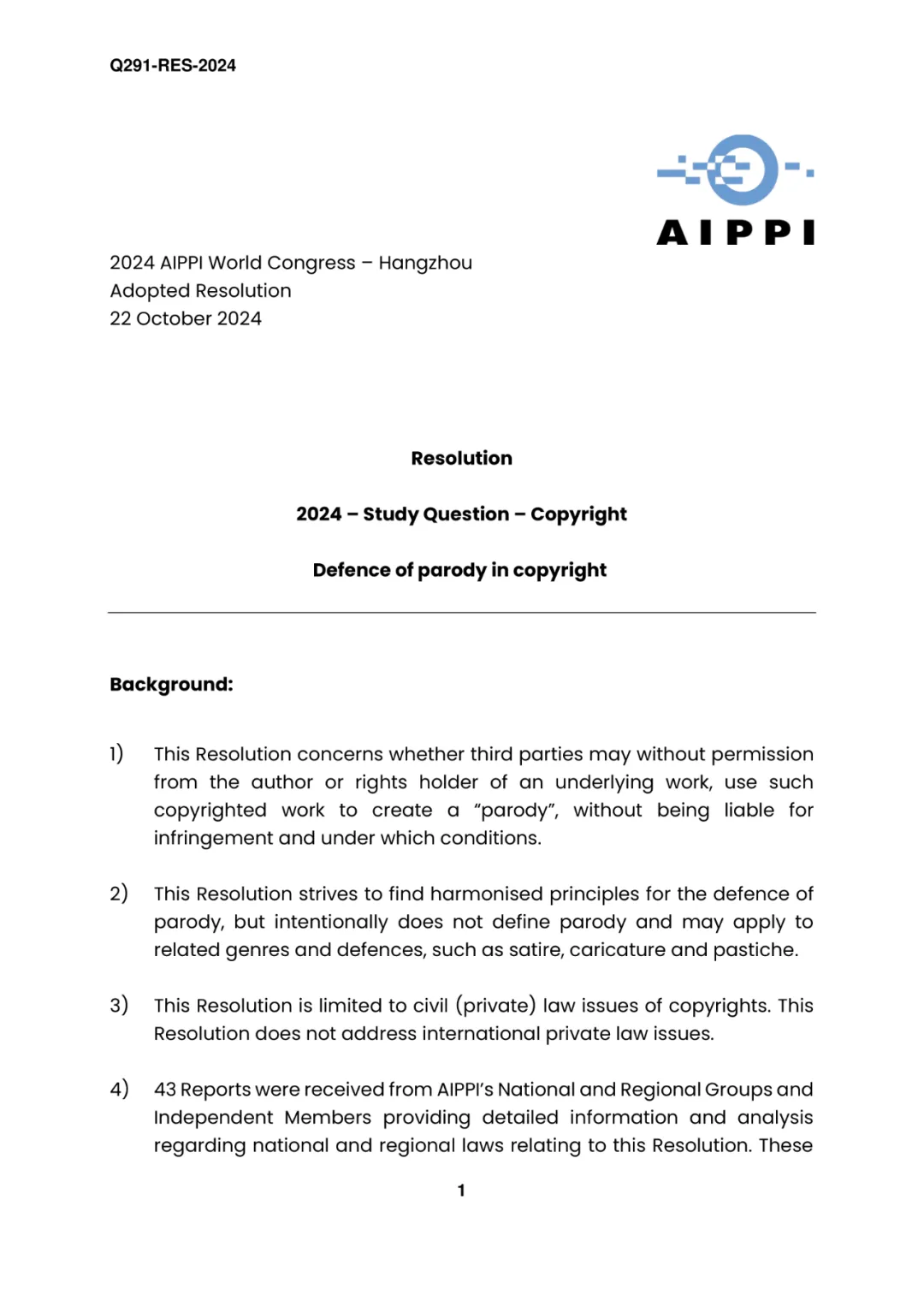
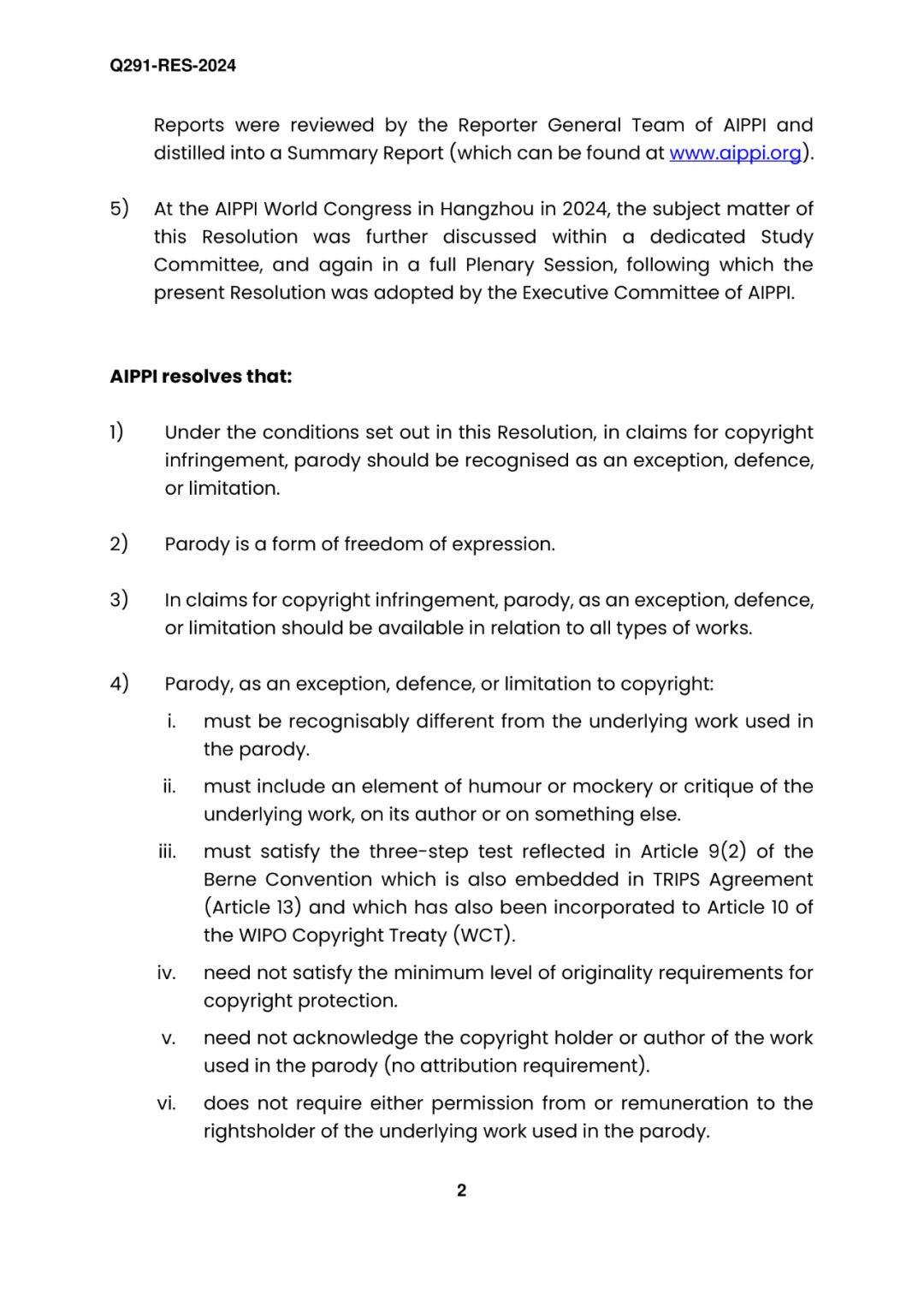
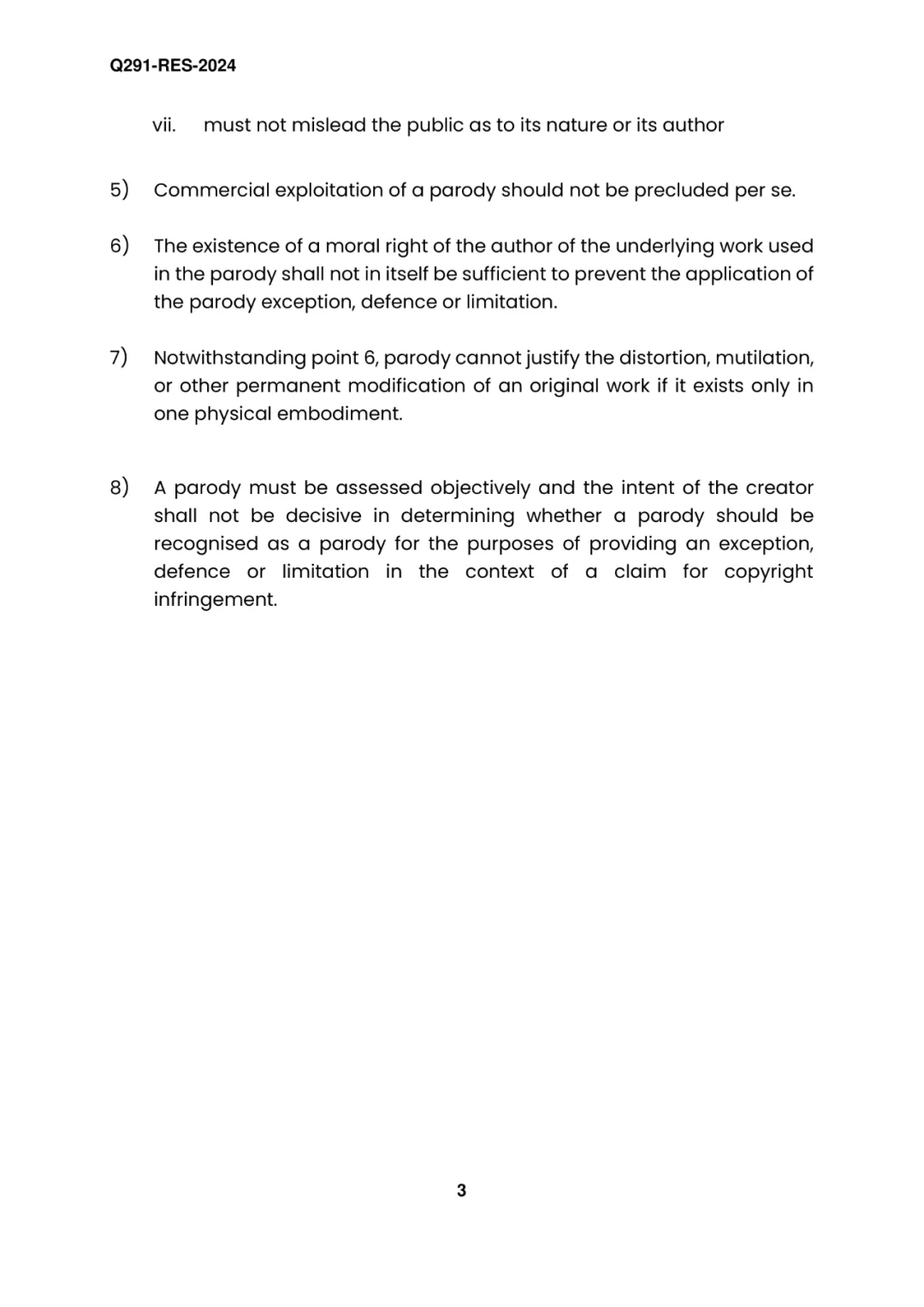
英文(文字版)
Q291-RES-2024
2024 AIPPI World Congress – Hangzhou
Adopted Resolution
22 October 2024
Resolution
2024 – Study Question – Copyright
Defence of parody in copyright
Background:
1) This Resolution concerns whether third parties may without permission from the author or rights holder of an underlying work, use such copyrighted work to create a “parody”, without being liable for infringement and under which conditions.
2) This Resolution strives to find harmonised principles for the defence of parody, but intentionally does not define parody and may apply to related genres and defences, such as satire, caricature and pastiche.
3) This Resolution is limited to civil (private) law issues of copyrights. This Resolution does not address international private law issues.
4) 43 Reports were received from AIPPI’s National and Regional Groups and Independent Members providing detailed information and analysis regarding national and regional laws relating to this Resolution. These Reports were reviewed by the Reporter General Team of AIPPI and distilled into a Summary Report (which can be found at www.aippi.org).
5) At the AIPPI World Congress in Hangzhou in 2024, the subject matter of this Resolution was further discussed within a dedicated Study Committee, and again in a full Plenary Session, following which the present Resolution was adopted by the Executive Committee of AIPPI.
AIPPI resolves that:
1) Under the conditions set out in this Resolution, in claims for copyright infringement, parody should be recognised as an exception, defence, or limitation.
2) Parody is a form of freedom of expression.
3) In claims for copyright infringement, parody, as an exception, defence, or limitation should be available in relation to all types of works.
4) Parody, as an exception, defence, or limitation to copyright:
i. must be recognisably different from the underlying work used in the parody.
ii. must include an element of humour or mockery or critique of the underlying work, on its author or on something else.
iii. must satisfy the three-step test reflected in Article 9(2) of the Berne Convention which is also embedded in TRIPS Agreement (Article 13) and which has also been incorporated to Article 10 of the WIPO Copyright Treaty (WCT).
iv. need not satisfy the minimum level of originality requirements for copyright protection.
v. need not acknowledge the copyright holder or author of the work used in the parody (no attribution requirement).
vi. does not require either permission from or remuneration to the rightsholder of the underlying work used in the parody.
vii. must not mislead the public as to its nature or its author
5) Commercial exploitation of a parody should not be precluded per se.
6) The existence of a moral right of the author of the underlying work used in the parody shall not in itself be sufficient to prevent the application of the parody exception, defence or limitation.
7) Notwithstanding point 6, parody cannot justify the distortion, mutilation, or other permanent modification of an original work if it exists only in one physical embodiment.
8) A parody must be assessed objectively and the intent of the creator shall not be decisive in determining whether a parody should be recognised as a parody for the purposes of providing an exception, defence or limitation in the context of a claim for copyright infringement.
中文
Q291-RES-2024
2024年AIPPI世界知识产权大会 – 杭州
通过的决议
2024年10月22日
决议
2024 – 研究专题 – 著作权
著作权领域的戏仿抗辩
背景:
1) 本决议涉及第三方是否可以在未经原作品的作者或者权利人许可的情况下,使用此类受著作权保护的作品来创作“戏仿”作品,而无需承担侵权责任,以及此等行为需要满足何种条件。
2) 本决议旨在为戏仿抗辩寻找国际协调的原则,但有意不对戏仿进行定义,并可能适用于相关体裁和抗辩,例如讽刺、漫画和模仿。
3) 本决议仅限于著作权的民事(私)法问题。本决议不涉及国际私法问题。
4) AIPPI国家及地区小组和独立成员提交了43份报告,就本决议相关的国家和地区法律提供了详细信息和分析。这些报告由AIPPI的报告总团队审查并提炼成一份总结报告(可在www.aippi.org查阅)。
5) 在2024年杭州举行的AIPPI世界知识产权大会上,本决议的主题在专门的研究委员会内进行了进一步讨论,并在全体会议上再次进行了讨论,随后AIPPI执行委员会通过了本决议。
AIPPI决议如下:
1) 根据本决议规定的条件,在著作权侵权主张中,应当将戏仿视为例外、抗辩或者限制。
2) 戏仿是表达自由的一种形式。
3) 在著作权侵权主张中,戏仿作为例外、抗辩或者限制,应当适用于所有类型的作品。
4) 戏仿,作为著作权的例外、抗辩或者限制:
i. 必须明显区别于戏仿中使用的原作品。
ii. 必须包含对原作品、作者或者其他内容的幽默、嘲讽或者批评元素。
iii. 必须满足《伯尔尼公约》第9条第(2)款所反映的三步检验法,该规程也被纳入了TRIPS协定(第13条)和《世界知识产权组织版权条约》(WCT)第10条。
iv. 无需满足获得著作权保护所需的最低限度独创性要求。
v. 无需注明戏仿所使用作品的著作权人或者作者(无署名要求)。
vi. 不要求获得戏仿中所使用原作品的权利人的许可,也不要求向其支付报酬。
vii. 不得误导公众对其性质或者作者的认知。
5) 戏仿不应当排除对其本身进行商业利用。
6) 戏仿中所使用原作品作者的精神权利的存在本身不足以阻止戏仿例外、抗辩或者限制的适用。
7) 尽管有第6点所述内容,如果原始作品仅以单一物理形态存在,则戏仿不能作为对原始作品的歪曲、毁损或者其他永久修改的正当理由。
8) 对戏仿的评估必须客观,在决定是否应当将某作品视为戏仿,以便在著作权侵权主张中提供例外、辩护或者限制时,创作者的意图不应当成为决定性因素。
Q292-RES-2024
无端的知识产权侵权指控
英文(图片版,共5页)
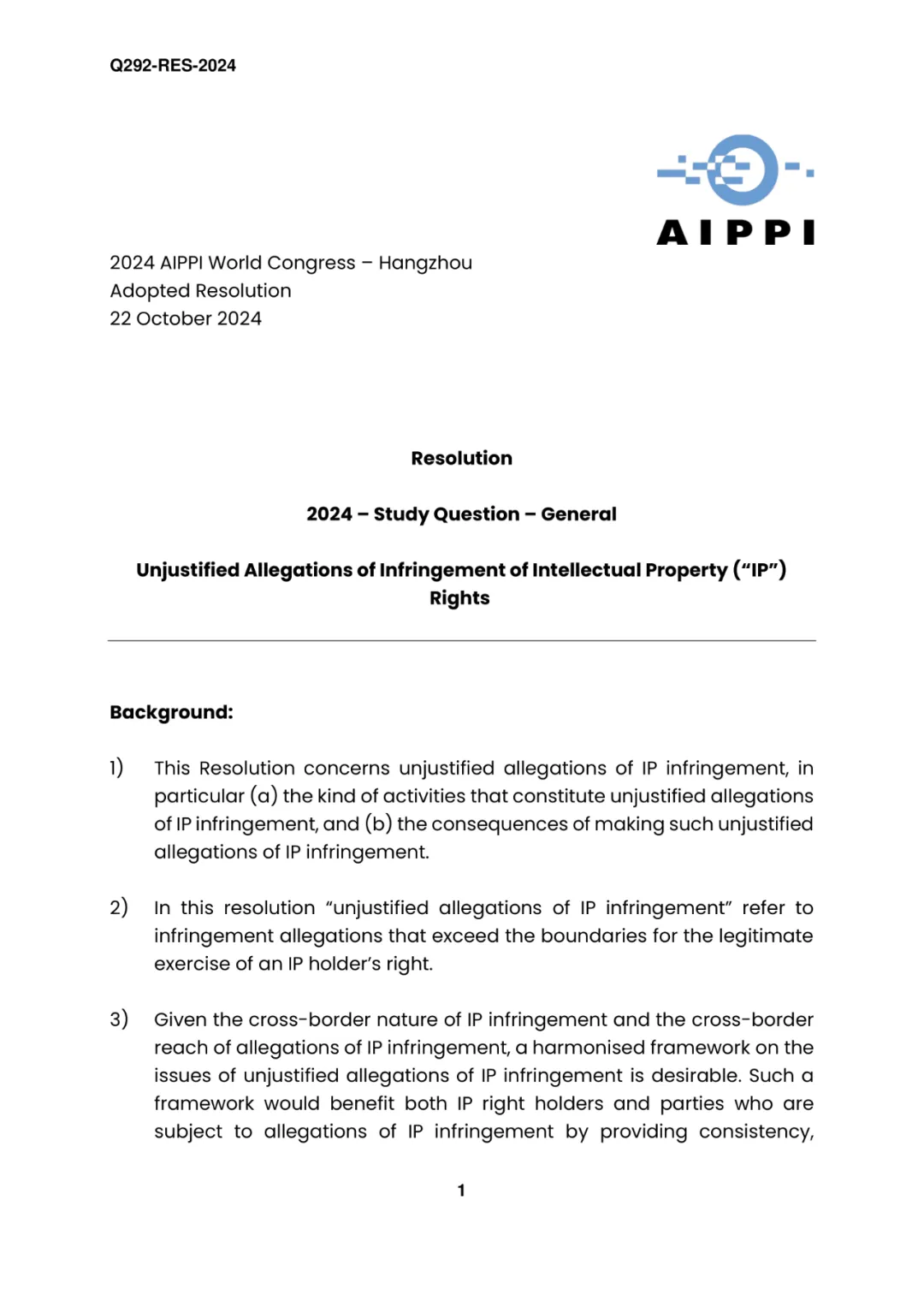
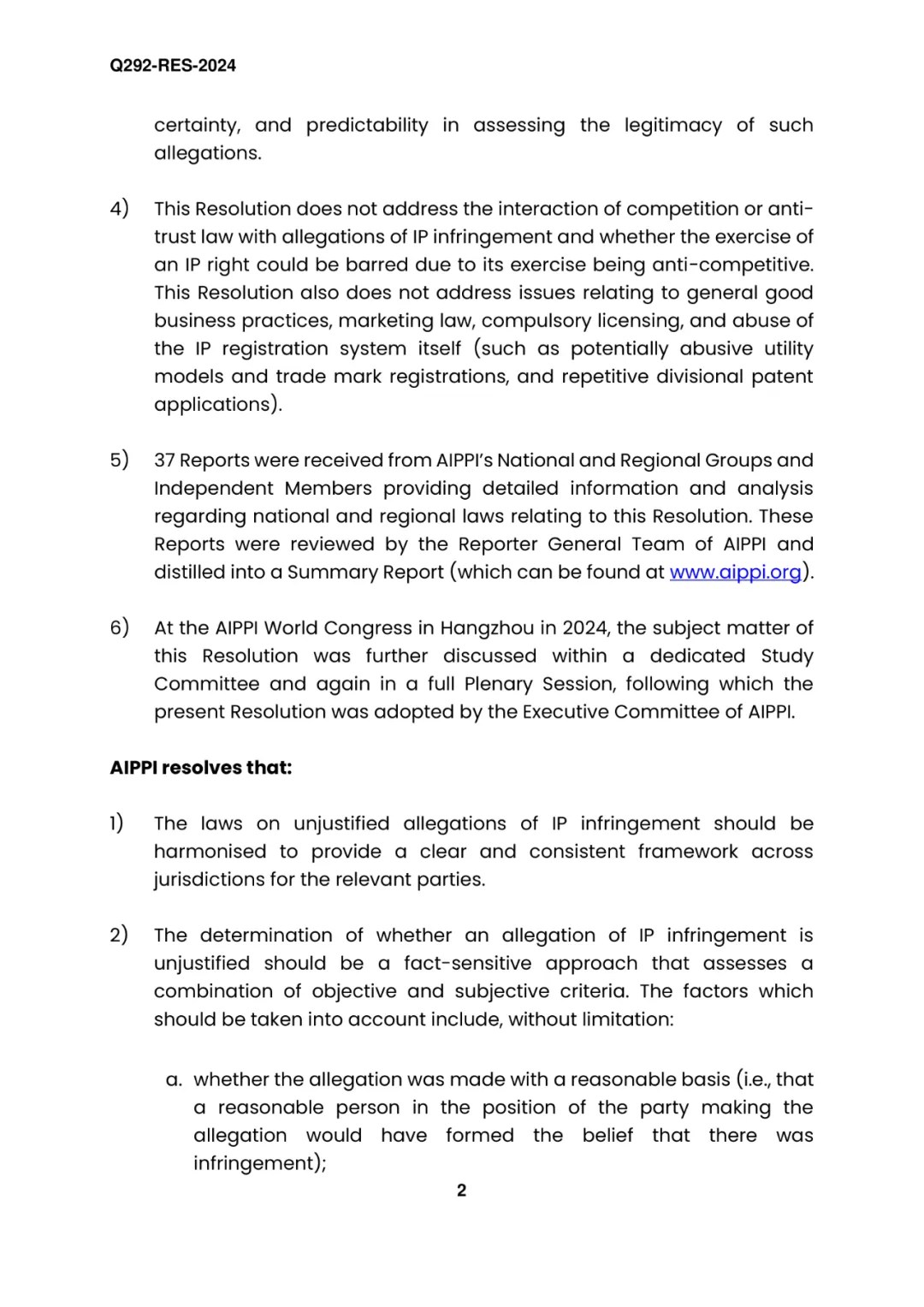
英文
Q292-RES-2024
2024 AIPPI World Congress – Hangzhou
Adopted Resolution
22 October 2024
Resolution
2024 – Study Question – General
Unjustified Allegations of Infringement of Intellectual Property (“IP”) Rights
Background:
1) This Resolution concerns unjustified allegations of IP infringement, in particular (a) the kind of activities that constitute unjustified allegations of IP infringement, and (b) the consequences of making such unjustified allegations of IP infringement.
2) In this resolution “unjustified allegations of IP infringement” refer to infringement allegations that exceed the boundaries for the legitimate exercise of an IP holder’s right.
3) Given the cross-border nature of IP infringement and the cross-border reach of allegations of IP infringement, a harmonised framework on the issues of unjustified allegations of IP infringement is desirable. Such a framework would benefit both IP right holders and parties who are subject to allegations of IP infringement by providing consistency, certainty, and predictability in assessing the legitimacy of such allegations.
4) This Resolution does not address the interaction of competition or antitrust law with allegations of IP infringement and whether the exercise of an IP right could be barred due to its exercise being anti-competitive. This Resolution also does not address issues relating to general good business practices, marketing law, compulsory licensing, and abuse of the IP registration system itself (such as potentially abusive utility models and trade mark registrations, and repetitive divisional patent applications).
5) 37 Reports were received from AIPPI’s National and Regional Groups and Independent Members providing detailed information and analysis regarding national and regional laws relating to this Resolution. These Reports were reviewed by the Reporter General Team of AIPPI and distilled into a Summary Report (which can be found at www.aippi.org).
6) At the AIPPI World Congress in Hangzhou in 2024, the subject matter of this Resolution was further discussed within a dedicated Study Committee and again in a full Plenary Session, following which the present Resolution was adopted by the Executive Committee of AIPPI.
AIPPI resolves that:
1) The laws on unjustified allegations of IP infringement should be harmonised to provide a clear and consistent framework across jurisdictions for the relevant parties.
2) The determination of whether an allegation of IP infringement is unjustified should be a fact-sensitive approach that assesses a combination of objective and subjective criteria. The factors which should be taken into account include, without limitation:
a. whether the allegation was made with a reasonable basis (i.e., that a reasonable person in the position of the party making the allegation would have formed the belief that there was infringement);
b. the motivation of the party who made the allegation, in particular whether the allegation was made with malicious intent or bad faith; and
c. the knowledge of the party who made the allegation, in particular whether said party had knowledge of (i) validity destroying circumstances or (ii) circumstances leading to non-infringement.
3) The mere fact that an allegation of IP infringement is later proved incorrect, either because of invalidity or non-infringement, does not in itself conclusively warrant a finding that said allegation was unjustified. However, at least the following should be considered as unjustified allegations of IP infringement:
a. Making an allegation of IP infringement while having actual knowledge of validity destroying circumstances;
b. Making an allegation of IP infringement while having actual knowledge of circumstances leading to non-infringement;
c. Making an allegation of IP infringement when the IP right does not in fact exist; and
d. Making an allegation of IP infringement aiming to obtain an injunction against an alleged further infringement when the invoked IP right has expired.
4) The mere fact that an allegation of IP infringement is later proved to be founded (e.g., by a decision on the merits), does not in itself conclusively warrant a finding that the allegation of IP infringement was justified.
5) The following should not categorically result in a finding that an allegation of IP infringement is unjustified:
a. Making an allegation of IP infringement when the party making the allegation knew or should have known that the infringement claim had a low likelihood of succeeding;
b. Making an allegation of IP infringement before the IP right has been granted provided that such communications does not assert the IP right as granted; and
c. Making an allegation of IP infringement when settlement negotiations or other dispute resolution processes are ongoing.
6) Any communication that can reasonably be understood by the person against whom the allegation of IP infringement is made as a threat of infringement proceedings, whether it is an express or implied threat, can constitute an unjustified allegation of IP infringement, subject to Paragraphs 3), 4) and 5). However, a mere notification of the existence of an IP right should not be deemed to constitute a threat of infringement proceedings.
7) National or regional laws should strive to provide greater clarity on what does or does not amount to a threat of infringement proceedings to enable parties to communicate without apprehension of incurring potential liability for unjustified allegations of IP infringement.
8) Any party, whether such party is the actual IP right holder or any other party (such as a non-exclusive licensee, exclusive licensee, group company, and/or other third party), who makes an allegation of IP infringement shall be liable if the allegation is found to be unjustified. Advocates, solicitors, and other IP or legal professionals acting in their professional capacity, and in accordance with applicable professional rules of conduct, on behalf of their clients shall not be personally liable for making unjustified allegations of IP infringement.
9) Proceedings for relief in respect of an unjustified allegation of IP infringement may be brought by the party to whom the allegation of IP infringement was made and/or by any other party whose interests have been, or might be, affected by the allegation.
10) When an allegation of infringement of an IP right has been determined to be unjustified, one or more of the following remedies, if applicable, should be available against the party who made the unjustified allegation:
a. Declaratory judgment that the allegation of IP infringement is unjustified;
b. Injunction;
c. Damages;
d. Fines;
e. Punitive damages;
f. Publication of the judgment;
g. Publication of correction;
h. Removal of the allegation; and/or
i. Reimbursement of court and legal costs.
11) The burden of proof in cases of unjustified allegations of IP infringement lies with the party who claims that an allegation is unjustified.
中文
Q292-RES-2024
2024年AIPPI世界知识产权大会 – 杭州
通过的决议
2024年10月22日
决议
2024 – 研究问题 – 通用
无端的知识产权侵权指控
背景:
1) 本决议涉及无端的知识产权侵权指控,尤其是(a)构成无端知识产权侵权指控的活动种类,以及(b)提出此类不合理知识产权侵权指控的后果。
2) 本决议中的“无端的知识产权侵权指控”,是指超出知识产权权利人合法行使权利界限的侵权指控。
3) 鉴于知识产权侵权的跨境性质和知识产权侵权指控的跨境影响,就无端的知识产权侵权指控问题建立一个国际协调的框架是可取的。这样的框架将在评估此类指控的合法性时提供一致性、确定性和可预测性,从而惠及知识产权权利人和受到知识产权侵权指控的各方。
4) 本决议不涉及竞争法或者反垄断法与知识产权侵权指控之间的相互作用,以及知识产权的行使是否可能因其具有反竞争性而被禁止的问题。该决议也不涉及与一般良好商业实践、营销法、强制许可和滥用知识产权注册制度本身有关的问题(例如可能滥用的实用新型和商标注册,以及重复的分案专利申请)。
5) AIPPI国家及地区小组和独立成员提交了37份报告,就本决议相关的国家和地区法律提供了详细信息和分析。这些报告由AIPPI的报告总团队审查并提炼成一份总结报告(可在www.aippi.org查阅)。
6) 在2024年杭州举行的AIPPI世界知识产权大会上,本决议的主题在专门的研究委员会内进行了进一步讨论,并在全体会议上再次进行了讨论,随后AIPPI执行委员会通过了本决议。
AIPPI决议如下:
1) 应当对关于无端的知识产权侵权指控的法律进行国际协调,以便为相关方提供一个清晰一致的跨司法管辖区框架。
2) 确定知识产权侵权指控是否无端,应当采用注重事实的方法,结合客观和主观标准进行评估。应当考虑的因素包括但不限于:
a. 指控是否具有合理依据(即,处于指控一方地位的理性人会认为存在侵权行为);
b. 提出指控的一方的动机,尤其是指控是否出于恶意或者不良意图;以及
c. 提出指控的一方是否知情,尤其是该方是否知晓(i)导致无效的情况,或者(ii)导致不构成侵权的情况。
3) 仅仅因为知识产权侵权指控后来被证明是错误的,无论是由于无效还是不构成侵权,这一事实本身都不足以最终断定该指控是无端的。但是,至少以下内容应当被视为无端的知识产权侵权指控:
a. 在明知存在导致无效的情况时提出知识产权侵权指控;
b. 在明知存在导致不侵权的情况时提出知识产权侵权指控;
c. 在知识产权事实上不存在时提出知识产权侵权指控;以及
d. 在援引的知识产权过期时,为了获得针对所谓进一步侵权的禁令,而提出知识产权侵权指控。
4) 仅仅因为知识产权侵权指控后来被证明成立(例如,通过实体判决)这一事实本身并不足以最终断定知识产权侵权指控是正当的。
5) 以下情况不应当一概导致认定知识产权侵权指控是无端的:
a. 当提出指控的一方知道或者应当知道侵权主张成功的可能性较低时,提出知识产权侵权指控;
b. 在知识产权被授予之前提出知识产权侵权指控,但是此类沟通并未断言知识产权已被授予;以及
c. 在和解谈判或者其他争议解决程序进行时提出知识产权侵权指控。
6)任何可以被受知识产权侵权指控的人合理理解为对其构成侵权诉讼威胁的沟通,无论是明示还是暗示的威胁,都可能构成无端的知识产权侵权指控,但是受第3、4和5段所述内容约束。然而,仅仅通知知识产权的存在不应当被视为构成侵权诉讼的威胁。
7) 国家或者地区法律应当努力更明确地说明什么构成或者不构成侵权诉讼威胁,以使各方能够在不必担心因无端的知识产权侵权指控而承担潜在责任的情况下进行沟通。
8) 任何一方,无论该方是实际的知识产权权利人还是任何其他方(例如非专有被许可人、专有被许可人、集团公司和/或其他第三方),如果提出知识产权侵权指控,且该指控被认定为无端指控,则应当承担责任。辩护律师、事务律师和其他知识产权或者法律专业人士以其专业身份、并按照适用的专业行为规则代表其客户行事时,不应当因提出无端的知识产权侵权指控而承担个人责任。
9) 就无端的知识产权侵权指控的救济程序,可由受到知识产权侵权指控的一方和/或利益已经或者可能受到该指控影响的任何其他方提起。
10) 当知识产权侵权指控已被确定是无端时,应当针对提出无端指控的一方提供以下一项或者多项救济措施(如适用):
a. 确认知识产权侵权指控无端的判决;
b. 禁制令;
c. 损害赔偿;
d. 罚款;
e. 惩罚性损害赔偿;
f. 公布判决书;
g. 公布更正;
h. 驳回指控;和/或
i. 偿付诉讼费和法律费用。
11) 在无端的知识产权侵权指控中,举证责任在于主张指控无端的一方。
(本内容不代表知产力立场)
封面来源 | 知产力












